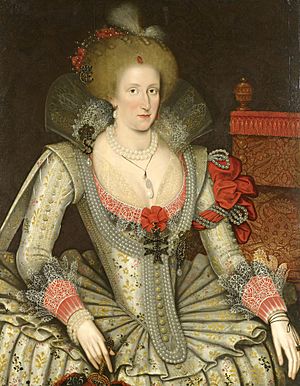Philip Jacobson (goldsmith) facts for kids
Philip Jacobson was a skilled goldsmith who lived in London. He worked for important royal figures like James VI and I, who was King of England and Scotland, and his wife, Anne of Denmark. A goldsmith is someone who makes and sells items out of gold, often including beautiful jewelry.

Philip Jacobson came from a family of goldsmiths in Antwerp, a city in what is now Belgium. He lived in a part of London called St Margaret's parish. In 1624, King James didn't allow Jacobson to become a full English citizen. This was because the King wanted to keep earning money from the taxes on Jacobson's successful business.
Contents
Working for the Royal Family
Philip Jacobson created many beautiful jewels for the royal family. He often worked with another goldsmith named Arnold Lulls.
Jewels for Princess Mary
In May 1605, Jacobson and Lulls made special jewels for Anne of Denmark. These included items set with sparkling diamonds and two dozen buttons. These gifts were for the baptism of Anne of Denmark's daughter, Princess Mary.
Gifts for Princess Elizabeth
Jacobson also supplied a valuable jewel worth £400 as a New Year's Day gift. This gift was for Princess Elizabeth, another of the King's daughters, in January 1607.
Gifts for Visiting Nobles
In June 1607, Jacobson made a stunning jewel for a visiting French noble, the Prince Joinville. This jewel looked like a rose made of diamonds with large, hanging pearls. It was valued at £2200, which was a huge amount of money at the time!
Buying Large Diamonds
Jacobson was also involved in buying valuable materials. In March 1614, he bought a very large diamond from the East India Company for £535. This company was famous for trading goods from faraway lands.
Investing in New Ventures
Beyond his work as a goldsmith, Philip Jacobson was also an "adventurer" in the Virginia Company in 1620. This meant he invested money in the company that was helping to set up colonies in America.
Goldsmith to the King
In 1624, a very important official named Lionel Cranfield, who was the King's chief financial advisor, officially appointed Philip Jacobson as a goldsmith to the King. Cranfield noted that other royal goldsmiths were either no longer working or rarely did jobs for the crown.
Special Items for the King
Jacobson made several special items for King James and his son, Charles I. He created two "picture-cases" (small cases for miniature portraits) for King James. For Charles I, he made a hat-band decorated with 37 diamonds and a diamond ring. He was paid £2380 for these items in 1627. Jacobson also gave Charles I a pair of gloves as a New Year's Day gift in 1627.
Valuing Crown Jewels
In June 1629, King Charles I asked Jacobson and other goldsmiths to help value some of the crown jewels. These were special jewels owned by the royal family for many generations. The King wanted to sell some of them.
The jewels to be valued included a jeweled circlet that belonged to Anne of Denmark. They also looked at two pearls from a famous jewel called the Mirror of Great Britain. One of the items valued was Anne of Denmark's diamond and ruby double cross, which was priced at £300. The total value of the jewels chosen for sale was £3000.

